Depopulation, Aging, and Living Environments
ebook ∣ Learning from Social Capital and Mountainous Areas in Japan · Advances in Geographical and Environmental Sciences
By Kenji Tsutsumi

Sign up to save your library
With an OverDrive account, you can save your favorite libraries for at-a-glance information about availability. Find out more about OverDrive accounts.
Find this title in Libby, the library reading app by OverDrive.



Search for a digital library with this title
Title found at these libraries:
| Library Name | Distance |
|---|---|
| Loading... |
This book provides perspectives on depopulated areas and regional social capital from positivistic field surveys. Among the developed countries of the world, Japan has a very small amount of national land, with almost 70% of it being in mountainous locations. Concentration of populations and economic capital into large metropolitan areas along with many depopulated and population-aged regions in the mountainous parts can be seen in the country. A very clear regional disparity has arisen in Japan, especially since the era of its high economic growth.
This book also offers critical suggestions for the shrinking societies of the developed world in the era of Society 5.0, the fifth stage of society where economic development is achieved and social issues are resolved by the fusion of cyber and physical space. To begin, the book refers to an outline of depopulation and depopulated areas in Japan. Then, it deals with issues of depopulation, out-migration from a mountainous village, revitalization of local industries, and maintenance of daily living functions in these areas.
This book is suitable for students and scholars of the social sciences, regional planners, staffs of government offices, members of NPOs, general citizens, and the many other people who are interested in sustainability of a region and a community in a shrinking social environment.
This book also offers critical suggestions for the shrinking societies of the developed world in the era of Society 5.0, the fifth stage of society where economic development is achieved and social issues are resolved by the fusion of cyber and physical space. To begin, the book refers to an outline of depopulation and depopulated areas in Japan. Then, it deals with issues of depopulation, out-migration from a mountainous village, revitalization of local industries, and maintenance of daily living functions in these areas.
This book is suitable for students and scholars of the social sciences, regional planners, staffs of government offices, members of NPOs, general citizens, and the many other people who are interested in sustainability of a region and a community in a shrinking social environment.







